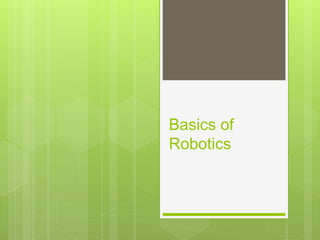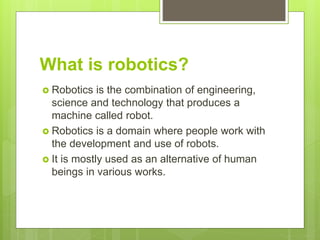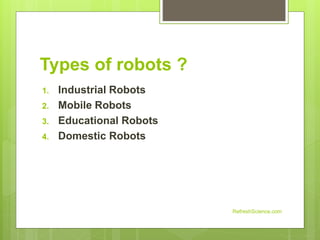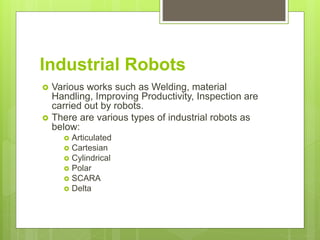Basics of Robotics.pptx
- 2. What is robotics? ï Robotics is the combination of engineering, science and technology that produces a machine called robot. ï Robotics is a domain where people work with the development and use of robots. ï It is mostly used as an alternative of human beings in various works.
- 3. Contd.. ï Robotics mainly deals with the design construction and operation of a robot and the computer systems for their control, feedback and information processing. ï It is a machine that is programmed to perform the given tasks and gather information from its surroundings. ï It works from a central microprocessor that helps to control the movements and they have sensors to sense the environment.
- 4. Why robotics ? ï The main purpose of robotics is to automate operations that humans do and replace them with machines that can do the work with better accuracy. ï As we know robotics is fully automated, it can process the dangerous and mundane jobs from humans with high productivity.
- 5. Contd.. ï While a human be able to do a piece of work at some speed we can definitely design a robot to do the same piece of work better, faster, economical and environmentally friendly. ï Because of its long run it can free humans from dangerous, repetitive and annoying jobs.
- 6. Laws of robotics: Asimov proposed three laws of robotics, they are: ï Law 1: A robot may not injure a human being or through inaction, allow a human being to come to harm ï Law 2: A robot must obey orders given to it by human beings, except where such orders would conflict with the first law ï Law 3: A robot must protect its own existence as long as such protection does not conflict with the first law.
- 7. Types of robots ? 1. Industrial Robots 2. Mobile Robots 3. Educational Robots 4. Domestic Robots RefreshScience.com
- 8. Industrial Robots ï Various works such as Welding, material Handling, Improving Productivity, Inspection are carried out by robots. ï There are various types of industrial robots as below: ï Articulated ï Cartesian ï Cylindrical ï Polar ï SCARA ï Delta
- 9. Mobile Robots ï Robots that move around legs, tracks or wheels. There are types of robots that can even handle radio active material. ï Types of mobile robots are ï Land based wheeled, tracked, legged robots ï Air based robots âplane, Helicopter ï Water based â Submarines ï Combinational robots
- 10. Educational Robots ï Robots that are used in education. They are abled to bring schools to students who cannot be able to present Physically. ï Types of educational robots are: ï Root ï Cubelets ï Dash and dot ï Ozobot bit ï Mbot
- 11. Domestic Robots ï There are two types one is to perform household tasks and the other one is modern toy that performs tasks like talking, walking etc.
- 12. Advantages of Robotics: ï No human intervention. ï Faster, precise and accurate. ï They can work 24*7 , so productivity increases. ï They can perform multitasking. So manpower gets reduced. ï They work in dangerous tasks, the risk of human health and safety is reduced. ï There is minimal risk if any failure occurs.
- 13. Disadvantages of Robotics: ï There are replacing human beings in many places which leads to widespread unemployment. ï They are costly to built. ï There is lack of emotions and conscience. ï They donât have on the spot decision making capability, they act only as they programmed. When an unexpected situation arises it would be difficult for a robot to go through it.
- 14. Future prospects of robotics: ï Many industries have started using robotic technology such as automotive, defence, pharmaceuticals , textiles, atomic energy etc. experts says that a moment may come when robots becomes smarter than humans. ï At present robots can rotate base of arm, bend elbow, rotate wrist etc. In future it may look, feel and act like humans. ï Realistic looking skins and hair can be fitted which allows the robot to react naturally in the environment.
- 15. Thank you !!















